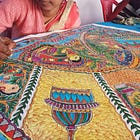Welcome to the Brown History Newsletter. If you’re enjoying this labor of love, please do consider becoming a paid subscriber. Your contribution would help pay the writers and illustrators and support this weekly publication. If you like to submit a writing piece, please send me a pitch by email at brownhistory1947@gmail.com. Don’t forget to check out our SHOP and our Podcast

Recommended Reads:
The Politics of Activist Art in India
Whose Art? Whose Resistance?

Deeply intertwined with India’s history of resistance is a rich tradition of artistic practice and a vibrant community of artists who have documented anti-authoritarian struggles. In recent years, movements such as the protests against the draconian Citizenship Amendment Act (CAA), the Farmers’ Protests since 2020, as well as other uprisings across the country and in South Asia have been vividly captured by painters, photographers, performance artists, sculptors, digital and graphic artists actively representing these struggles in their work. This period has been celebrated as an era where art serves as both solidarity and resistance, with particular attention on the significance of art emerging from and representing marginalized communities.
But how much of this art truly belongs to, and serves, the oppressed communities it claims to represent?
Between 2019 and 2020, collectives such as Creatives Against CAA, Drawing for Resistance, the Fearless Collective, and the Zanana Ensemble emerged as powerful platforms where art served not only to document and showcase resistance but to actively perform it. At the same time, popular art fairs, biennales, art galleries, and curated exhibitions saw a growth of art that reclaimed and reinterpreted symbols often deemed overtly political, sparking new conversations about the intersection of art and activism. These works and spaces compel us to critically interrogate the very notion of what is deemed “political”.
Yet, this moment of artistic fervor raises critical questions. Who are the artists who are ultimately platformed in such spaces, and what kinds of art are deemed worthy of display? Can protest art, housed in a gallery, retain its revolutionary intent, or does its context dilute its message? And what about the the artists whose work is unplatformed, forgotten, or ignored, in this politics of curation and (in)visibility, this aesthetic aphasia, and what does their exclusion reveal about the hierarchies embedded in the art world’s mechanisms of recognition and representation?






